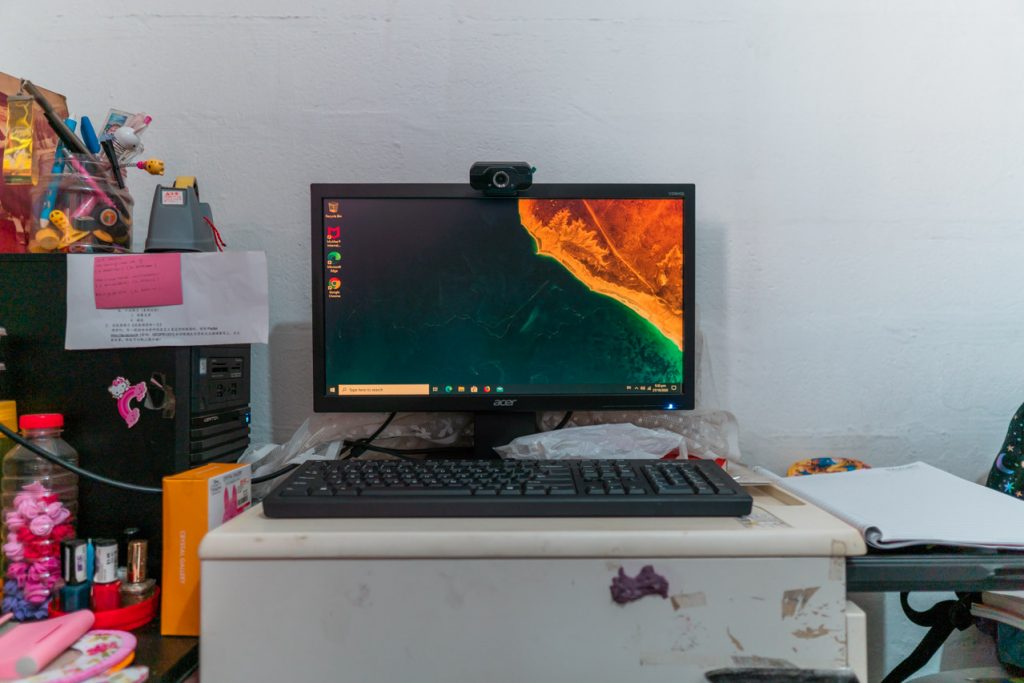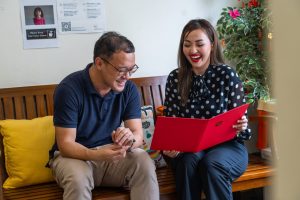Names have been changed at the interviewees’ request to protect their privacy.
Their computer, however, rests neglected on a repurposed dressing table. A stack of bills buries the computer mouse. Before turning on the device, Bernice, Esther’s mother, asks her daughter: “Which is the computer wire?”
Neither Esther nor her parents—who are in their early 30s—know how to operate the computer. Before Covid-19, no one needed to use a computer in their everyday life: Esther’s primary school education was conducted through physical lessons and printed worksheets; Bernice is a full-time housewife whose chores do not extend to the digital; Esther’s father worked as a bouncer at a nightclub.
But the pandemic changed everything. By forcing everyone to shelter at home, computers—and the ability to operate them—became crucial for all aspects of life.
Students were forced to go online to attend classes and do homework; office work moved to the digital realm as people worked from home; job interviews were conducted over Zoom; grocery shopping shifted from NTUC trips to flicks on the RedMart app.
As a result, families who do not own a computer or know how to use them fear that they will be left behind in the country’s sudden surge towards digitalisation.
From her interactions with her tech-savvy classmates, Esther is aware that her family is one of those who struggle with basic digital usage. As she describes how she found it difficult to log in to Student Learning Space during Home-based Learning, she wonders out loud, almost with a hint of shame and guilt: “Why are some of my classmates so good with computers, but I don’t know how to use?”

A study of a nationally representative sample of 5021 Singaporean children, conducted by NUS sociology chair Jean Yeung, found that 8% of children who live in rental flats do not have an internet connection. More pressingly, a whole 44% of them do not have a computer at home.
In comparison, only 4% of those living in private condominiums or landed properties do not have a computer at home.
This gulf between the haves and the haves-not of the digital world is known as the digital divide.
“In the context of Singapore, this refers to the uneven distribution of technology access and utilisation,” says Ruth Tan, Executive Director of South Central Community Family Service Centre (SCCFSC), a social service agency that supports low-income and vulnerable families in the Bukit Ho Swee area.
There are generous schemes in Singapore and voluntary organisations that ease the financial burden of lower income families who may not be able to afford a computer.
For instance, groups like Engineering Good refurbished and distributed over 2,700 donated laptops to needy families during the circuit breaker. Esther received her computer free of charge, courtesy of the NEU PC Plus Programme and the iNSPIRE Fund.
But the fastest computer is an inert piece of metal in the hands of someone who doesn’t know how to use it. Ruth acknowledges that “the government has put in a lot of effort to close the gap: nation-wide broadband, Wireless@SG, the NEU PC Plus Programme … the divide has narrowed this way.”
And yet it is not enough.
Shaziah Wasiuzzaman, Assistant Director of SCCFSC, elaborates: “It’s more important that this enables you to do things online that help you progress in life, besides just using social media. Currently, I’m not sure if that’s possible with the devices and skills our community members possess … Access and resources are not equal.”

As both Ruth and Shaziah allude to, the digital divide is not bridged just by providing access to equipment and connectivity. Digital literacy, in fact, is the main factor widening the digital gap between families from different income and age groups.
Anecdotally, it’s not uncommon to see the elderly struggle to top-up their EZ-Link cards via the automated machines at MRT stations. The consequences are not terrible: they can simply approach the service counter for help.
However, not knowing how to navigate something like SingPass—already ubiquitous in our daily life for things like SafeEntry—is more disastrous. Former Nominated Member of Parliament Anthea Ong points out that “SingPass is required to access many such services including checking Central Provident Fund (CPF) accounts, which are regularly required to apply for welfare schemes, checking medical appointments or medical tests results and prescriptions.”
In other words, for those who do not possess a digital device or knowledge of how to navigate digital platforms, applying for welfare schemes and scheduling medical appointments may prove so onerous that they would rather not seek help. More worryingly, SingPass is only a sign of things to come, as more government and essential services move into the digital realm as part of Singapore’s drive to become a “Smart Nation”.
Furthermore, now that the pandemic has shifted the bulk of our economy online, things like buying meals can prove a challenge.
“Covid changed a lot, especially if you want to buy things,” Bernice reflects. “Like food. A lot of places are closed and only let us order online. I’ve never used apps to order before. So during this time I had to quickly learn. I’ve only learnt a bit, like using the McDonald’s and KFC app. A lot haven’t learnt, like GrabFood and foodpanda. I still need to improve.”
The sudden digitalisation of the economy and workplace also means that more jobs will move online. But many lower-income families are still unfamiliar with basic IT skills that we take for granted, like word processing, says Denise Liu, a researcher at SCCFSC.
Interviewing for a job over Zoom also presents a difficulty as many of them “have no clue what Zoom is”, Ruth adds.
The digital divide, then, prevents them from applying for and securing jobs. As a result, people from lower-income backgrounds are prevented from accessing opportunities that could potentially uplift their socioeconomic station.

Bernice knows that she needs to pick up digital skills to keep up with the changes in society. She bought her first smartphone 5 years ago, and while “it was difficult to use at first,” she gradually familiarised herself with the interface—though she confesses, with an embarrassed smile, that she mostly spends her time on games and social media like Facebook.
To that end, both she and her husband want to properly learn how to use a computer and acquire skills like using Microsoft Excel and performing other basic computing functions.
Immediately after expressing that wish, Bernice, as if not wanting to let herself harbour expectations that might not be met, dismisses it: “For low income families like us, it might be difficult to attend classes and pick up these skills because we don’t have time and money. But if you are economically secure, it’s probably easier to enrol in classes and learn new things.”
Maybe Esther can teach you? I offer, thinking that her school would surely have taught her these skills.
“My school has only taught us how to type on the keyboard,” Esther shares. “I wish my school would teach me more.”
With the Ministry of Education’s (MOE) emphasis on inculcating digital skills in students, such that all upper primary school students will attend coding classes, it was surprising to hear how little exposure to IT Esther has had while in school.
Bernice confirms that this is true. “The school didn’t teach them how to visit websites, no Word or Excel … so all these things, we don’t know completely.”
In fact, when I ask Esther what digital skill she wishes to pick up, she offers very hesitantly: “I want to learn how to log into the computer … it’s very hard.”
Thus, while Esther’s family count themselves lucky to be the recipients of a free computer, they are understandably frustrated at the lack of opportunities for them to learn basic IT skills, or the difficulty of seeking help to troubleshoot their IT problems.
For example, when Esther and Bernice were locked out of SLS because they tried the wrong username-password combination too many times, they had to return to the school to ask Esther’s teacher for help, who approached the school’s admin office, who turned to the IT staff, and so on in the bureaucratic chain, before Esther could log in and start doing her homework.
“There’s no one direct person we can ask for help,” Bernice sighs. “And because of Covid and the circuit breaker, we were forced to use the computer for everything, but were not allowed to approach anyone for help.”
Then, again, I hear the lament that she uses to punctuate all her sentences: “It’s difficult because we are completely clueless about computers.”

It’s undeniable that we—individuals, civil society, voluntary organisations, and the government—can do much more to narrow this gap. People with more expertise and experience tackling the digital divide have written many illuminating Op-Eds on this subject, so I will not attempt to parrot them or offer my half-baked solutions.
(For those interested: Professors Irene Ng and Lim Sun Sun have proposed classifying Internet access as a public utility similar to water and electricity; former NCMP Anthea Ong has elucidated “the gaps in government intervention”; researchers Dr Natalie Pang and Dr Chew Han Ei have argued for understanding the digital divide as an issue of equity and inclusion, not just as a binary between access to, and lack of, devices … and these are just a small selection among many other pieces available online.)
Regardless of how we choose to tackle the issue of the digital divide in Singapore, Ruth emphasises that one thing is certain: “The old rules don’t apply in the new world.” Computers and digital literacy are no longer “wants”, but “needs”.
Many assistance schemes require applicants to “prove themselves as deserving to get a PC,” grumbles Ruth. Such a process is not only condescending, but also out-dated. Today, people don’t “deserve” a PC. They need one—and the requisite digital skills—to get a job, work, go to school, and improve their situation in life.
This thought is constantly weighing on Bernice’s mind.
“Everything nowadays is computer, technology … Esther is already in P3. She should be learning these things,” Bernice half laments and half hopes.
Embedded in her voice is a fear that Esther will, like her, be deprived of opportunities and grow up an outcast in a rapidly digitalising country.





